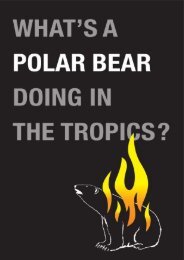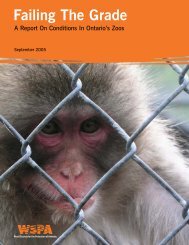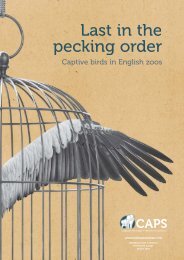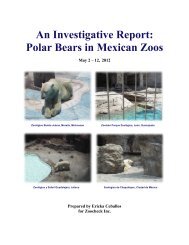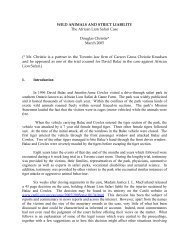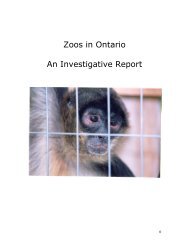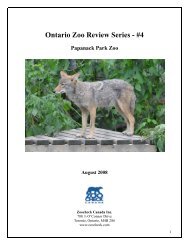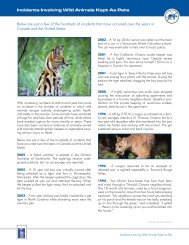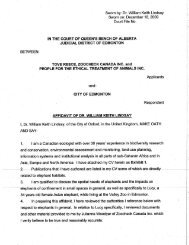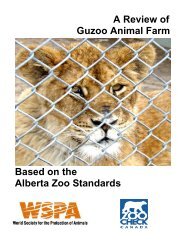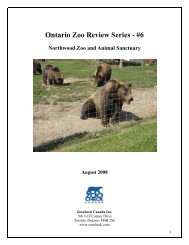STATUS OF BEAR WELFARE
STATUS OF BEAR WELFARE
STATUS OF BEAR WELFARE
Create successful ePaper yourself
Turn your PDF publications into a flip-book with our unique Google optimized e-Paper software.
Status of Bear Welfare in Cherokee, North Carolina<br />
INTRODUCTION<br />
On Sunday, October 25, 2009, four expert investigators—Rob Laidlaw, Lydia Lefebvre, Else<br />
Poulsen, and Debi Zimmermann—were invited by PETA to visit Chief Saunooke Bear Park<br />
(CSBP), Cherokee Bear Zoo (CBZ), and Santa’s Land (SL) in the Great Smoky Mountains of<br />
Cherokee, North Carolina. The parameters of each facility as they relate to the bears’ husbandry<br />
needs were inspected, including daily and seasonal husbandry, enclosure design, environmental<br />
enrichment programming, diet, and veterinary care.<br />
AUTHOR BIOGRAPHIES<br />
Rob Laidlaw<br />
Rob Laidlaw is a chartered biologist who has been involved in captive wildlife welfare issues for<br />
the past 25 years, including the assessment of captive wild animal housing and husbandry.<br />
During that time, Laidlaw has reviewed and/or visited approximately 1,000 zoos and captive<br />
wildlife facilities around the world. A portion of his work has involved reviewing and assessing the<br />
conditions in which bears are kept in captivity. Laidlaw is the founder and executive director of<br />
Zoocheck Canada, a national wildlife protection charity, established in Toronto, Canada, in 1984<br />
and has served as project manager and technical advisor for the World Society for the Protection<br />
of Animals.<br />
Lydia Lefebvre<br />
Lydia Lefebvre grew up living and working around wildlife in northern Ontario and obtained her<br />
early knowledge of wildlife and bears by working in forests and remote locations. Her career in<br />
the fields of natural resources and environmental consulting expanded to wildlife fieldwork and<br />
led her to become a zookeeper charged with the care of bears. As a zookeeper in Ontario, she<br />
learned modern husbandry methods and environmental enrichment programming. Lefebvre has<br />
improved the lives of bears in captivity by observing and interpreting bear behavior in order to<br />
determine the animals’ needs. She has also trained bears through the exclusive use of positive<br />
training methods in order to aid in the monitoring of their health and veterinary care. She has<br />
worked for years as a volunteer and sometimes as a board member with organizations such as<br />
the Alliston & District Humane Society, the Northern Ontario Animal Welfare Society, and<br />
Zoocheck Canada. As a consultant, Lefebvre has evaluated and commented on facilities and<br />
enclosures holding native and exotic species. She has completed two degrees in parks and forest<br />
recreation and ecotourism management and is currently pursuing a degree in science and animal<br />
behavior at the University of Western Ontario.<br />
Else Poulsen<br />
Else Poulsen began her career in animal behavior in the early 1980s working as a field biologist<br />
in Alberta’s energy industry. She later became a zookeeper at zoos accredited by the U.S.-based<br />
Association of Zoos and Aquariums (AZA) and the Canadian Association of Zoos and Aquariums.<br />
Poulsen became a specialist in captive bear behavior, husbandry, and management. She found it<br />
difficult to accept that the bears in her care displayed abnormal behavior such as pacing, so she<br />
set out to better the animals’ lives. This led her to research captive bear problems, publish her<br />
AN INVESTIGATIVE REPORT <strong>OF</strong> CHIEF SAUNOOKE <strong>BEAR</strong> PARK, CHEROKEE <strong>BEAR</strong> ZOO, AND SANTA’S LAND | 6



